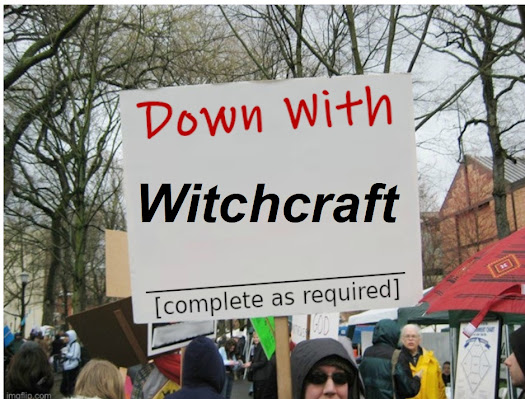The term "Witch-Hunt" gets thrown around a lot.
The anti-Communist hysteria in the US during the McCarthy-era has been frequently described as a Witch-hunt. Stalin's relentless and violent persecution of his (perceived) enemies also gets the term. Donald Trump was (and still is) fond of describing any criticism of his behaviour as a "Witch-hunt".
It's important to understand that most people who use the term in the present day are being metaphorical. No one is suggesting that there are people out there in our modern society who are seriously hunting for actual witches; it's just a figure of speech.
It's not as if anyone really thinks that their enemies are secretly worshipping Satan or stealing babies to harvest their bodily fluids for some unspeakable cannibalistic ritual or anything. That would be bad.
To misquote Sigmund Freud, sometimes a Witch-Hunt is just a Witch-Hunt.
Arthur Miller has been described as the greatest American playwright of the 20th Century, probably. In the 1940s, he had been very close friends with the film director Elia Kazan (we'll be getting to him in a couple of weeks) but that friendship came to an abrupt end when Kazan gave testimony before the House Un-American Activities Committee and named names.
Horrified by what HUAC was doing in the name of anti-Communism, Miller decided to dive headfirst into the Witch-Hunt metaphor by removing the metaphor part and writing a play about an actual, literal Witch-Hunt.
The result was of course The Crucible (1953), Miller's masterpiece about the Salem Witch Trials.
Ironically, it was The Crucible itself that made Miller a target of the HUAC investigations. He was denied a passport by the federal Government in 1954 (preventing him from attending the play's London premiere) and was subpoenaed to appear before the committee in 1956.
Watching the play, it's not hard to understand why the committee took it personally. It was very personal, and very obviously a direct attack on everything the House Un-American Activities Committee was doing (I guess the "Witch-Hunt" was still a metaphor after all).
Needless to say, filming The Crucible in Hollywood would have been political suicide while the committee was still active, although it was filmed in France (and in French) in 1957. As with the London premiere, the passport-less Arthur Miller was trapped in the US and unable to participate in the French production.
Miller's own screen adaptation of The Crucible did not appear until 1996, when British director Nicholas Hytner filmed it with Daniel Day-Lewis and Winona Ryder, amongst others.
Daniel Day-Lewis, a self-confessed "method" actor, threw himself completely into the part of John Proctor by building the house his character lives in, refusing to bathe for the duration of the production, and marrying Arthur Miller's daughter.
The Crucible may have premiered seventy years ago, but it remains one of the most brutal and unrelenting portraits of collective hysteria and bigoted persecution one could ever witness.
Its most depressing aspect is probably the degree to which it remains relevant to this day.
We will be screening The Crucible at 7.30 on Thursday, the 9th of February at the Victoria Park Baptist Church.














Comments
Post a Comment